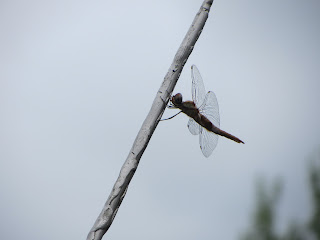We start in the house office buildings, which are connected to the capitol and the senate buildings by a series of tunnels. It took me a few weeks to get used to the maze!
After passing through a security check, we walk past the national high school art competition winners. The representative from each district can select one piece of art from their district. Some of the paintings and photographs are incredible!
Next, we walk to the Capitol Visitors' Center, added in 2008, that serves as the welcoming center for the thousands of daily visitors to the capitol. When the cornerstone of the capitol was laid by George Washington in 1793, the building planned was much smaller than what we see today. In addition to being rebuilt after partially burning in 1814, the capitol has expanded with the needs of Congress and the inclusion of more states.
The crowning glory of the Capitol Visitors' Center is Emancipation Hall, a massive underground hall with views of the capitol dome in the skylights. Emancipation Hall features an overflow of the national statuary hall collection, including one of Washington State's statues (Mother Joseph, the namesake of St. Joseph's Hospital). Emancipation Hall also houses the plaster model of the bronze Statue of Freedom that tops the dome. At 19 feet, she is the tallest standing statue in the capital city (Lincoln would be taller if he was standing in his memorial).
From Emancipation Hall, we go back above ground level to the Crypt. Originally meant to be the final resting place of George Washington, it now houses some of the national statuary hall collection statues (including a replica of the magna carta and a statue of Robert E. Lee, something I always chuckle at). In the crypt, 40 columns hold up the Rotunda above and surround a marble stone in the center of the room that serves as the symbolic center of the D.C. street system, which radiates from that spot like the spokes of a bicycle wheel. It is also said that touching the star brings good luck!
Next, we head to the Senate Vestibule. The original entrance the senate side of the capitol, the room that now serves as the entrance to the old Supreme Court chambers. The characteristic corn capitals on the columns were a deliberate attempts to demarcate American architecture from European.
The Senate Vestibule leads to the room that served as the Senate chambers before becoming the Supreme Court chambers in 1810. Thomas Jefferson made his inaugural address here. Roger Taney, the fifth Chief Justice, presided in this room for many years and the clock at the back of the room is kept five minutes fast to honor his love of punctuality. Also famous for his Marbury v. Madison case, Taney handed down the Dred Scott Decision in this room. The room was originally lit by whale oil, which is honored today by the low lighting.
Just outside the old Supreme Court Chamber is one of my favorite rooms. The enormous chandelier hanging above the circular space was purchased from a Methodist church in D.C. that was being demolished in the 1950s. Samuel Morse also sent the first Morse code in this space.
Next, we ascend to the Rotunda and to one of the most iconic spaces in history. The artwork of Constantino Brumidi dominates the inside of the dome with The Apotheosis of Washington and the Frieze. Brumidi actually fell from his scaffolding when he was painting the Frieze and hung there until he was rescued. Already an old man at that point, he decided to retire and the Frieze was eventually finished by a series of artists commissioned by Congress.
 The statues in the Rotunda, where dignitaries are allowed to lie in state after their death, are all of Presidents with the exception of the bust of MLK, Jr. and a statue of early feminists. Lucretia Mott, Susan B. Anthony, and Elizabeth Cady Stanton are joined by an unfinished piece of stone signifying the ongoing effort toward equality.
The statues in the Rotunda, where dignitaries are allowed to lie in state after their death, are all of Presidents with the exception of the bust of MLK, Jr. and a statue of early feminists. Lucretia Mott, Susan B. Anthony, and Elizabeth Cady Stanton are joined by an unfinished piece of stone signifying the ongoing effort toward equality.
The old Senate chamber, where the Missouri Compromise was decided and Charles Sumner was caned by Preston Brooks, is the next stop. The room was used until we had 64 Senators and outgrew the cramped space. The balcony above was where women could sit and hear the debates (with a modesty curtain to cover their exposed ankles, of course).
And finally, to National Statuary Hall, the original home of the House of Representatives. Tiles on the floor mark the original locations of the desks of future presidents. In 1864 the hall welcomed a collection of statues, and each state was invited to submit two. The second of Washington's statues (of missionary Marcus Whitman, a physician who served the tribes of SE Washington and was later massacred) is in this room as well.
.JPG)
























































